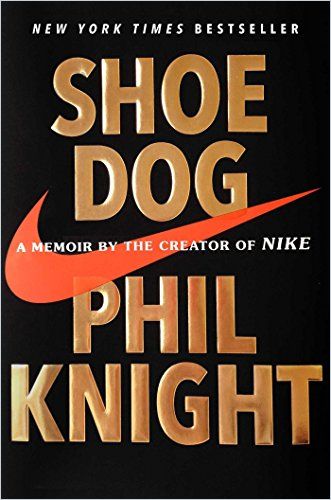As few entrepreneurs could, Nike founder Phil Knight proves himself worthy of his own story.

Building Nike
The King and the Court
Builders of empires eventually come to regard themselves as emperors, and who’s going to tell them they shouldn’t? Looking back at his life, Nike founder Phil Knight often writes as if he were a king recalling moments that seemed insignificant at the time, but turned out to be character-building or lesson-providing or profoundly fateful.
I wanted to leave a mark on the world. I wanted to win. No, that’s no right. I simply didn’t want to lose.Phil Knight
For example, Knight tells many stories of childhood or teenage buddies who loomed large for him, but who have scant impact on the practical outcomes of these stories. Keeping track of all the characters weaving in and out of the book requires flipping back and forth among pages to remember who matters and who does not.
Vivid Portraits
Knight crafts memorable, vivid portraits of compelling, quixotic characters, such as legendary University of Oregon running coach and shoe-design pioneer Bill Bowerman, and equally legendary, inspirational champion runner Steve Prefontaine. Knight’s continual jousting with his Japanese customers, partners and adversaries proves likewise compelling, even if he packs in too much minor detail. The stories of Knight’s Japanese adventures make his book an engaging read and a fount of worthwhile lessons for entrepreneurs.
History is one long processional of crazy ideas. The things I loved most – books, sports, democracy, free enterprise – started as crazy ideas.Phil Knight
Though his detailed memories probably seem to constitute a direct, clear narrative to Knight, the book is quite episodic, with several chapters functioning as stand-alone lessons, illustrations or anecdotes. This means you could move right along to read – or reread – the chapters that intrigue you most.
The Moral
Knight writes in a relaxed, engaging tone, with conversational rhythm and pace. The most arresting chapters read like the tales of a favorite uncle telling you the ups and downs of his life and career.
Let everyone else call your idea crazy…just keep going. Don’t stop…that’s the precocious, prescient, urgent advice I managed to give myself, out of the blue…I believe it’s the best advice – maybe the only advice – any of us should ever give.Phil Knight
In the introduction, Knight reveals the constant, underlying moral of each chapter, of his life and his way of doing business: “Never quit.” Never consider quitting. Even when you don’t know what you’re doing or why, keep moving forward.
Zen Insight
Knight writes briefly but clearly about the importance of Zen to his outlook on life. In his view, Zen suggests that any idea of the self is a dangerous illusion. Zen disregards the past and future in favor of the eternally present now. To be content means rejecting the illusion of self and ego, and vesting in sublime emptiness, the sense great athletes experience in a perfect performance.
In the beginner’s mind there are many possibilities, but in the expert’s mind there are few.Shunryu Zuzuki, Zen Mind, Beginners Mind
Trying to find Zen peace amid overwhelming career crisis gave Knight insight at crucial moments in his career, and kept his sometimes-volatile temper from getting the better of him and clouding his judgment.
Onitsuka
In 1962, Knight visited the Onitsuka Company showroom in Kobe, Japan. He told its executives he was there for Blue Ribbon Sports. He didn’t tell them Blue Ribbon consisted of himself and his one investor, his dad. He also didn’t tell them it operated out of his parents’ house. He asked to be the exclusive distributor of Onitsuka’s Tiger athletic shoes in the western United States. Onitsuka’s executives said yes, and Knight’s life as a shoe salesman began. Over the decades as Nike grew, Onitsuka became his greatest ally and, during various changes of management, his greatest, most dangerous opponent.
I knew that Japanese cameras had made deep cuts into the camera market, which had once been dominated by Germans. Thus…Japanese running shoes might do the same thing. The idea interested me, inspired me, then captivated me. It seemed so obvious, so simple, so potentially huge.Phil Knight
Onitsuka tried to take back Knight’s contracted exclusive right to distribute its shoes in certain US territories. That’s when Knight realized he couldn’t rely on the company or its promises. He understood that Onitsuka could take his US distributorship from him despite signed contracts. To be free, he had to create his own shoe. This triggered the birth of Nike. Knight later engaged in protracted legal struggles with Onitsuka. His philosophy of never stopping or giving in led him to continue the expensive legal battle even when his partners and lawyers told him the outlook was grim. Eventually, however, Knight and his partners prevailed.
Penny Parks
Knight married Penny Parks, an early Blue Ribbon employee, on September 13, 1968. He credits her for being his rock in life and always supporting him even when he worked constantly, traveled alone worldwide and spent more energy on the job than at home.
The man who moves a mountain begins by carrying away small stones.Confucius
For a man at his level of success, Knight is touchingly forthright about his flaws as a person and a husband. One flaw he doesn’t seem to suffer is disloyalty. He believes in his friends and associates and believes that a true bond will endure. He notes that he and Penny remain married and in love to this day.
Steve Prefontaine
Steve “Pre” Prefontaine was once America’s greatest middle-distance runner. He had an unusually intense, competitive nature. Prefontaine fought with and depended upon Oregon coach Bill Bowerman, and fought against US hypocrisies regarding “amateur” athletes that kept American runners broke while their competitors from every other country had salaries from their governments. Knight and Bowerman loathed the complex shenanigans that Adidas and Puma – whose owners were two brothers who were themselves bitter rivals – went through to sneak money and shoes to Olympic athletes.
What if there were a way, without being an athlete, to feel what athletes feel? To play all the time, instead of working? Or else to enjoy work so much that it becomes essentially the same thing.Phil Knight
Tales abounded of envelopes of cash stuffed into athletes’ pockets. Unlike Pre, Knight felt no moral qualms about such behavior. He lamented only that, in the early days, he had no extra cash to spend on pursuing athletes.
Later, as Nike blossomed and the official rules changed, Pre became the second athlete to endorse and wear Nikes. With his first endorsement check, Pre bought an MG convertible sports car. Several years later, at the peak of his abilities and fame, he drove the MG home after a party, hit a boulder and flipped the car. It landed on Prefontaine, killing him.
Bill Bowerman
University of Oregon running coach Bill Bowerman was a legendary figure in American track and field and a mentor to champions, including the mercurial Pre. He was Knight’s college track coach, close friend, adviser and business partner, and the inventor of a groundbreaking sole for running shoes. Bowerman always tried to improve running shoes for his athletes. His greatest discovery came when he poured various kinds of rubber into his waffle iron at home, heated the rubber and applied the resulting form to the bottom of running shoes. After much trial and error, Bowerman found a compound of just the right consistency and durability. Thus was born Nike’s distinctive, enduring and incredibly successful “Waffle Sole.”
There’s a kind of exuberant clarity in that pulsing half second before winning and losing are decided. I wanted that, whatever that was, to be my life, my daily life.Phil Knight
Knight ends the book with a few yarns from Nike’s early struggles and triumphs. He says Bowerman hated being called coach and preferred the title “Professor of Competitive Responses.” Knight describes him as a tough-love leader who inspired determination and sacrifice from his athletes. Knight and Bowerman worked together for many years. Before Nike was born, Knight and Bowerman became handshake “50-50” partners in Knight’s athletic shoe endeavors and remained partners until Bowerman’s death. Knight saw Bowerman as the soul of the company, and always believed “if Bowerman isn’t happy, Nike isn’t happy.”













